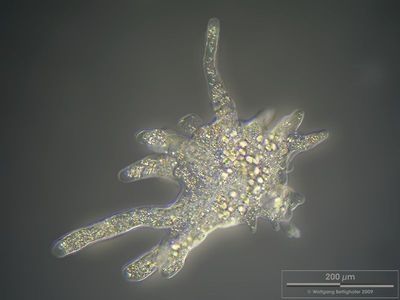
EUKARYOTA
Organisms With Nuclei
[© micro*scope]
Chapter Outline
- Description of Eukaryotes
- Classification of Eukaryotes
- Excavates
- Amoebozoa
- Rhizaria
- Alveolata
- Stramenopiles
- Algae
- Opisthokonta

Links to external sites will appear in pop-up windows.
Of the three domains of life, two are not eukaryotic: Bacteria and Archaea (Chapter 17). The third domain, Eukaryota, is the subject of this chapter and the following twenty chapters. The extra space given to this one domain is based more on our familiarity with the domain than on any sense of importance or diversity. The two prokaryotic domains likely have a far greater number of species but are on a much smaller scale than their human observers and are more difficult and/or less appealing to study. From what we have observed, their chemical diversity is much greater than that between organisms within the domain Eukaryota.
Many of the chemical cycles and cellular structures of the smallest, "lower" eukaryotic organisms are exactly the same as those of the highest plants and animals, including humans. All eukaryotes are characterized by having a nucleus in which the DNA is stored and generally have intracellular organelles such as mitochondria, chloroplasts, endoplasmic reticula, and others.
This chapter focuses on those eukaryotic organisms which do not fit into one of the three main kingdoms of the domain: Viridiplantae (Plants), Metazoa (Animals) and Fungi. In the five-kingdom system of classification which is still probably most widely used by the general public, this chapter would be called "Protista" or "Protoctista". Most of the organisms in this chapter are unicellular but some, like giant kelp, are multicellular and quite large.
Resources:
- Protista Images. University of Wisconsin. http://botit.botany.wisc.edu/images/130/Protista_I/.
- Protista Tutorials. Cornell University. http://biog-101-104.bio.cornell.edu/BioG101_104/tutorials/protista.html.
- BL4130: Phycology. Ryan Lukach. Michigan Tech University. http://forestry.mtu.edu/students/ralukach/algae.html.
- Subkingdom Phycobionta
- Images of Various Eukaryotes
- Exploring Early Eukaryotic Evolution: Diversity and Relationships Among Novel Deep-Branching Lineages
- BIOL 1060 - Kingdom Protista - Nova Southeastern University
- Protists - Reef Education Network
- Protistologist's Home Pages
- Protsville
- Protozoa and Microsporidia
- Alg@line Phytoplankton Image Gallery - Finnish Institute of Marine Research
- Checklist of phytoplankton in the Skagerrak-Kattegat - Goteborg University
- Endosymbiosis and The Origin of Eukaryotes - Dr. John W. Kimball
- Seaweed Site - National University of Ireland
- An Insight Into Micropalaeontology - University College London
- Axopodial Contraction in Heliozoa -
- Antarctic Protist Culture Collection
- Phytoplankton Image Library - Cedar Eden
- Protistology
- Various Videos
- Various Images
- Photostnthetic Life - Various Groups
- Eukaryotes in Extreme Environments
- Protist Information Server
- Phycological Images (Japanese)
- A Guide To Modern Radiolaria
- Marine Flora - Monterey Bay Aquarium Research Institute
- Links - Winnipeg Nights
| [ Previous Page ] | [ Next Page ] |